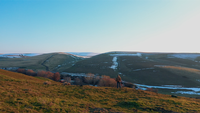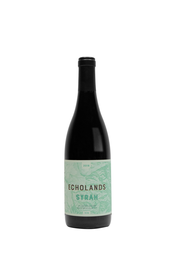What caught my eye was the involvement of one of the best minds in wine…Doug Frost, MW & MS…getting ready to launch a Syrah from Walla Walla from a venture in which he is a principal. Full disclosure: Doug has been a friend for roughly two decades, and though we only see one  another occasionally, when you’re a journalist writing about someone with whom you’ve enjoyed multiple meals on at least three continents and in your own home–you’d better come clean.
another occasionally, when you’re a journalist writing about someone with whom you’ve enjoyed multiple meals on at least three continents and in your own home–you’d better come clean.
With that noted, the soon-to-be released 2018 Syrah (already on offer through the website) will convince you that my interest in this project wasn’t skewed by friendship. Before addressing that wine, here’s a brief outline of the Echolands enterprise. Frost is CEO, his fellow resident of Kansas City, Brad Bergman is Chairman, Taylor Oswald is Winemaker and Sadie Drury is Vineyard Manager. They purchased their own vineyard on the Oregon side of the Walla Walla AVA in 2017, prepped it for two years, and planted in 2019. We’ll see when they decide that fruit from their estate vineyard is ready to roll, but for now, they’re working with fruit from the highly-regarded Les Collines and Seven Hills Vineyards.
The lineup will include Cabernet Sauvignon, Merlot, Cabernet Franc, Petit Verdot and Grenache, in addition to Syrah. It is easy enough to piece together the intended style of the wines from the website: objectives include freshness and nerve, moderate oak, fidelity to a single appellation, and ability to age. You’ll enjoy learning more if you consult the Echolands website, which expresses  these objectives without getting preachy, and describes the venture in a way that doesn’t seem self-important—a fact that will come as no surprise to readers who know Doug.
these objectives without getting preachy, and describes the venture in a way that doesn’t seem self-important—a fact that will come as no surprise to readers who know Doug.
The 2018 Syrah will set you back all of $38, though it performs well above that price, serving thereby as an object lesson in the serious-but-not-self-important ethos of the project.
I particularly admire this wine as a lover of wines from the northern Rhône, which are also dear to Doug’s heart. What is most distinctive about those wines—and most often missing from their Syrah counterparts from other parts of the world (emphatically including the USA) is bright acidity and a sense of freshness. The first release shows both of those characteristics in spades, without any of bland “muddiness” or monolithic character that marks so many New World renditions.
It features red berries up top, along with some very faint wood notes (much more about spice than toast, let alone smoke), and some darker fruit tones show up in the midpalate before the bright red notes re-assert themselves in the finish, which is pleasantly tart and very long…and pure.
As noted above, the winery website addresses ability to benefit from aging as an objective. Having tasted a press sample of a debut vintage of a wine that’s still to be released, I’m obviously  extrapolating when assessing the 2018 in that respect. However, trying any young wine again after sloshing it around and leaving it open for 24 hours is a pretty telling test of age-worthiness, and this wine…did not budge an inch over that span.
extrapolating when assessing the 2018 in that respect. However, trying any young wine again after sloshing it around and leaving it open for 24 hours is a pretty telling test of age-worthiness, and this wine…did not budge an inch over that span.
That’s an especially important attribute for New World Syrah, because it suggests that with time to develop tertiary characters from bottle aging, an ultra-pure wine like this can develop the savory characters that other Rhône-style aspirants only “achieve” by means of deliberately dirty winemaking. We need not dwell on that, as the upshot here is clear: This is a wine to buy and age and try at different points in its development. It is already delicious…but I am confident that it will get much better. I scored it at 93 Points, and recommend it enthusiastically.
Connect on Twitter: @Michael_Franz
